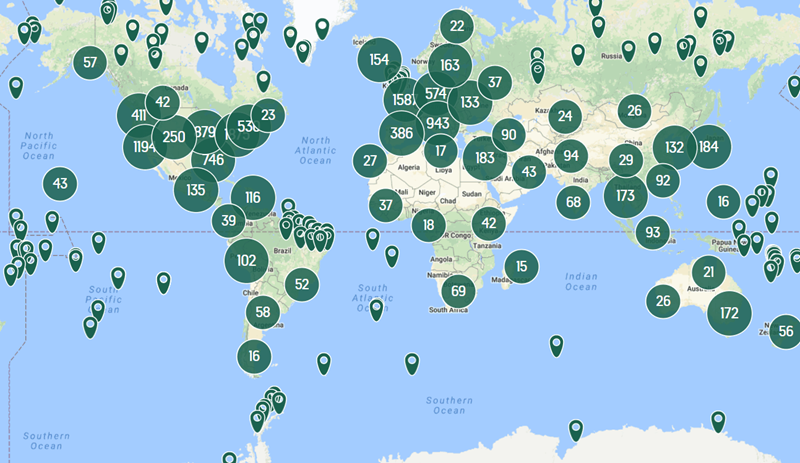Interactive maps and locations have revolutionized the way we navigate and explore our world. These digital tools offer real-time updates, making them invaluable for travelers, explorers, and anyone who needs to get from point A to point B. They provide remarkable detail, showcasing everything from major highways to tiny alleyways in cities across the globe.
Some interactive maps even offer street view features, allowing users to virtually traverse unfamiliar terrain. Others include layers of information like weather patterns, traffic density, and topographic details. With the rise of augmented and virtual reality, the future of interactive maps and locations promises even more immersive experiences.

Best Fallout 4 Companions
In the expansive world of Fallout 4, companions prove to be invaluable assets for survival and exploration. Among the array of available companions, several stand out due to their unique abilities and personal quests. Firstly, Nick Valentine, a synth detective, brings a compelling backstory and useful hacking skills. Piper, a tenacious reporter, is admired for her investigative skills and resilience in combat.
Dogmeat, the loyal canine, is a fan favorite because he can sniff out enemies and items while also being immune to negative affinity. Paladin Danse provides heavy firepower with his Power Armor and a strong moral compass, making him an excellent choice for those who prefer a combat-focused approach.
Lastly, Codsworth, the Mr Handy robot, offers versatility with flamethrower and saw blade attacks, as well as an amusingly formal demeanor. Each of these companions adds a unique flavor to the Fallout 4 experience.
Introduction to Interactive Maps
Interactive maps are a digital innovation that presents data in a geographical layout, enabling users to engage with the displayed information. These maps are more than just static images; they possess the ability to zoom in and out, retrieve specific data by clicking on particular areas, and move in various directions. This technology can be used in various fields, including tourism, education, real estate, and public health, to present complex data in a user-friendly way.
The power of interactive maps lies in their capacity to translate vast and complicated data sets into understandable visual representations, allowing for a more comprehensive analysis. By providing a dynamic and visually appealing presentation of data, interactive maps have revolutionized the way we understand and interpret geographical information.

Benefits of Interactive Mapping
Interactive mapping offers numerous benefits, enhancing understanding and simplifying data interpretation. By visually representing information on an accessible platform, it enables users to engage and interact with complex data, promoting deeper comprehension. This tool can be incredibly beneficial in planning and decision-making processes.
For instance, in urban planning, it allows planners to visualize potential impact and understand community needs better. In education, it fosters learning by making abstract concepts more tangible. Interactive mapping can also facilitate communication between different sectors, breaking down barriers and promoting collaboration.
Furthermore, it can be adapted for various purposes, from analyzing socio-economic data to monitoring environmental changes. By enabling the manipulation of data layers and perspectives, it provides a comprehensive and flexible tool that can cater to diverse needs.
Types of Interactive Maps
Interactive maps are a dynamic tool that enable users to engage with and manipulate geographical data for a more personalized experience. These maps come in various types, each suited to different needs. For instance, thematic maps display specific themes or subjects, like population density or climate zones.
Heat maps visualize data through colors to represent varying degrees of intensity, commonly used for tracking user behavior on websites. On the other hand, topographic maps illustrate physical features of the land, such as mountains and rivers. There are also web-based interactive maps, which are typically powered by GIS software and often used for urban planning.
Meanwhile, multimedia maps incorporate text, audio, and video elements to provide a more immersive experience. Interactive maps are invaluable resources in various fields, from tourism and education to science and technology.

Using Interactive Maps for Navigation
Utilizing interactive maps for navigation has revolutionized the way we travel and explore. These digital tools, whether standalone devices or smartphone applications, provide real-time data and directions to users, thereby eliminating the need for traditional paper maps.
Some of their key features include voice-guided instructions to ensure safe driving, 3D views for better understanding of the terrain, and traffic updates to help avoid congested routes. They also offer the ability to search for local amenities such as restaurants, gas stations, and hotels.
Furthermore, the interactive nature of these maps allows for personalization according to individual preferences, like saving frequently visited locations and setting preferred routes. Not only do these maps make navigation effortless, they also enhance the overall travel experience.
Future Trends in Interactive Mapping
As technology continues to advance at an unprecedented rate, the field of interactive mapping is set to witness significant trends that will reshape the landscape of geographical information systems. Augmented reality (AR) and virtual reality (VR) are expected to play a predominant role in enhancing the user experience, providing immersive 3D models and real-time navigation.
Artificial Intelligence (AI) will contribute to the advancement of predictive analytics, enabling users to anticipate changes in traffic patterns or environmental conditions. Furthermore, the integration of big data will allow for more precise and detailed maps, enabling users to access comprehensive information about a specific location.
Lastly, the advent of 5G technology will enhance real-time data transmission, improving the speed and efficiency of interactive maps. These future trends highlight the potential of interactive mapping to transform various sectors, from urban planning to disaster management.
